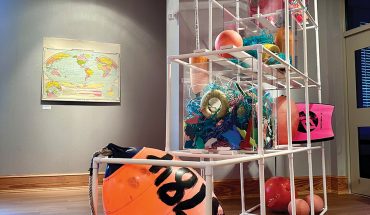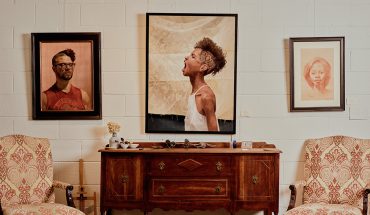TWO DECADES YOUNG
Carolina Ballet’s fresh perspective
by Jessie Ammons
photographs by Juli Leonard
When the curtain fell on Carolina Ballet’s first performance in 1998, the audience exited Memorial Auditorium to a hushed downtown Raleigh. “There weren’t even restaurants open after the theater,” says Melissa Podcasy, ballet master and founding company member.
Today, audiences exit Memorial Auditorium to a lively downtown Raleigh with plenty of options for a post-show bite or drink. “Raleigh has grown up around us,” says principal dancer Margaret “Peggy” Severin-Hansen, another founding company member. It’s an energy reflected in the nationally renowned professional dance company: As Carolina Ballet celebrates its 20th anniversary, new co-artistic director Zalman Raffael brings both fresh perspective and seasoned vigor to the troupe. His approach is rooted in tradition and talent, with a renewed emphasis on community engagement. “We’ll always push to innovate and bring the highest level of technique to the stage,” Raffael says, “but realistically, we can’t do that without the support of the community.”
Under Raffael, Carolina Ballet in the next 20 years will be plugged-in but still studious, both innovative and traditional. Raffael wants to continue to “institutionalize Carolina Ballet,” so that dance becomes a necessary part of Raleighites’ art diet.
“My hope is to reach people in a meaningful way, so that they understand the importance of what art is, and what it can do to, or for, their own lives.”
The foundation
Since its inception in 1997, Carolina Ballet has produced a large volume of high-caliber shows. “Here we are 20 years later because of a lot of tenacious hard work and excellent product,” ballet master Podcasy says. Podcasy has had a front-row seat from her roles as a founding company member and former principal ballerina, and as wife to founding artistic director Robert Weiss. Carolina Ballet is Weiss’s vision and his career’s work; his latest act is his protege, Raffael.
“As a choreographer, your clay, your medium, is the dancers,” Weiss says. “If you’re lucky, you get to also teach a young choreographer.” Raffael, known as Zali, came to Raleigh in 2005 to dance for Carolina Ballet. He trained at the School of American Ballet in New York City, an education shared by much of the Raleigh dance company. (Weiss began his career at the New York City Ballet, where he was eventually a principal dancer.) Weiss says Raffael’s talent for choreography was always evident, but “it’s an expensive, risky investment to mentor a choreographer, because you have to get them studio time, you have to get them dancers. The work can’t be done alone.” Raffael, he says, was worth the investment. When Weiss considered the future of Carolina Ballet, he says he knew it would involve the young choreographer as more than a dancer, in a larger creative role.
Now, at 32, Raffael is Weiss’s first-ever co-artistic director. Raffael has been transitioning into the role for two years and says he feels that he has found his creative voice. It’s with this voice he plans to impact the public, but it’s also a voice that speaks a language largely taught to him by Weiss. “While he is on planet earth, I will always consult with him,” Raffael says of working for and alongside Weiss. “The relationship I have with my mentors are what give me energy and enthusiasm. We have an unmatched rapport.”
Weiss and Raffael’s mutual respect is evident in Carolina Ballet’s anniversary season, which began in September and runs through May. Of the eight productions – each production includes five to 11 performances – many of them are Weiss originals. “He has created a repertoire of ballets that are the foundation of this company: his Messiah (in November), his Nutcracker (this holiday season), his Sleeping Beauty (in May), his Romeo & Juliet (in February). They are the bread and butter.” Mixed in are a guest-choreographed world premiere set to Ravel’s Bolero (in March); the return of New York City Ballet co-founder George Balanchine’s Serenade, which was performed by Carolina Ballet in its inaugural 1998 season; and a Weiss-Raffael collaboration, The Legend of Sleepy Hollow & Other Haunted Tales, that premiered in October. There’s old, there’s new, there’s tried-and-true. “We bring more ballets to the stage than almost any other American company annually.”
Behind the curtain, in the company’s studio on Atlantic Avenue, the pace is constant, nearing relentless. Like Weiss before him, Raffael sees no other way. “We have to push to have this as a part of the thread of Raleigh.”
‘Just go’
At this point, the ballet is certainly a thread of Raleigh’s cultural identity. From day one, there has been a devoted audience, one that has continued to grow. The company estimates its more than 1,000 performances have reached 1 million people, and the past two years have seen a consecutive 20 percent growth in ticket sales.
The growth can be attributed, in part, to consistency. “We have been so consistent in the amount that we perform, in the amount that we are out in the community, and in the quality of the work,” Severin-Hansen says.
The growth can also be attributed to new audiences. Principal dancer Yevgeny Shlapko, who joined the ballet in 2007, has especially noticed a younger demographic. “Zali’s fresh perspective on things is bringing in a new crowd,” Shlapko says. “He’s loyal to the traditions Ricky (Weiss) set up for us, and he’s building on it.”
Raffael says the arts community in Raleigh today is robust and eager, providing an opportunity for dancers to be involved beyond the studio, and in turn bringing a broader audience into the theater. “We have these young, beautiful, talented, intelligent people that are the vessels of this art form, dance. They’re interesting and they should be. My hope is that they become immersed in the community. … When they are accessible, the place becomes accessible.”
Accessibility is key and has been, by all accounts, the constant challenge to overcome. “People always ask me, ‘What does the ballet mean?’ and ‘Would it have been more helpful with a narrator?’ … If you’re watching it and you’re trying to figure it out, you’re never going to understand. You have to give it time,” Raffael says.
“My hope is that we can get people to come enough to … understand that whatever the ballet makes you feel is the feeling it’s supposed to.”
“Just go,” Podcasy says. “You just go to the ballet. The lights go down, the curtains go up, and there it is. I don’t think it needs to be explained.”
An even younger audience can be found in the dancers’ own students. Most of the core performers also teach at local dance schools, including principal dancers Severin-Hansen and Shlapko. “Performing is something that I give to myself and that I give back to the audience,” Severin-Hansen says. “It’s my learning process: how my body works, how I connect to the audience. What I really enjoy, also, is to be able to give that experience back to the kids.” She leads Carolina Ballet’s summer intensive; is the assistant director of Triangle Academy of Dance in Cary; and teaches at Triangle Youth Ballet in Chapel Hill. Teaching allows her to give back to her vocation, she says, by taking what she learns on a professional level and “translating it to the next generation.”
Shlapko considers teaching another Carolina Ballet thread woven into Raleigh. “I remember being a student and seeing one of my teachers perform at the ballet. Seeing them on stage, applying the corrections they had told me in the studio to themselves – everything clicks. It’s really something incredible to experience.” Shlapko’s experience came full-circle last fall, when he danced a lead role in Sleepy Hollow. “I went to do my bow and I saw this group of kids standing in the audience – they were my students. I’m sure it was a big deal for them to see their teacher on stage. And I will not forget looking out and seeing them. It’s fulfilling.”
Forward thinking
When Weiss arrived in Raleigh 20 years ago, he hoped to create an avenue for “professional art,” Podcasy says. “The product we put on stage is very diverse. It’s a mix of classical and contemporary and it’s very theatrical. The audience demands that of us, and we have given it to them since the beginning. We don’t talk down to our audience.” Raffael’s task is to interpret the legacy for a fast-paced, diversions-aplenty culture.
What can we expect? At first, “subtle little things that I believe will make a difference.” Take this season’s company headshots: Each dancer chose his or her own outfit and was encouraged to be candid for the photos. In a disciplined, ensemble-driven operation, the portraits are a chance for individual personalities to shine through.
The mix of old and new will continue. “We create new ballets and we preserve the old ones. That is the ballet.” Increasingly, the new might run the gamut, with a spirit of measured experimentation. If something doesn’t work, Carolina Ballet will move on to the next production. Now that the groundwork is laid, there is a company-wide faith that there will always be the next production. “It will still be here in 20 years, I am certain of that,” Podcasy says.
“Having the co-artistic direction of Zali is like having two Michelin star chefs in the kitchen,” Shlapko says. “You know you’re going to have really good dishes.” Raffael is at the helm, with Weiss’s steady guidance. While the two decades of work is not lost on either of them, in characteristic fashion, Raffael flips the paradigm. He cites the hundreds of years of ballet before them, and the dynamism of Carolina Ballet’s dancers today. “This is a humongous milestone. It is so incredible what Ricky has done. But it really is just the beginning.”




